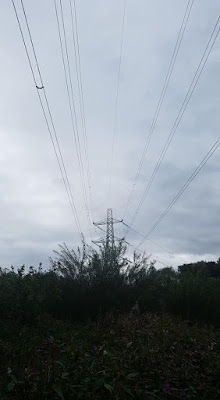Bryn Celli Ddu, Anglesey
One of the side effects of this summer's Covid restrictions has been me dragging my family round a good number of Neolithic sites. These places have several Corona advantages- open air, free to visit, you can go without touching anything and they are crowd free. When we visited Castlerigg stone circle near Keswick in the Lake District (on the way to Scotland at the start of August) my seventeen year old daughter was genuinely surprised to find other people there as well as us. 'there are other people here' she said, slightly amazed, and then followed this with (in tones dripping with teenage sarcasm), 'I thought it was only us who were arsed about stone circles'.
Castlerigg, Keswick
In the early summer we started by driving to Mellor, in the hills overlooking Stockport, which has an iron age hill fort and down the valley and up the hill a long barrow (the barrow is on private land behind barbed wire sadly). A week later we drove to The Bridestones, a chambered cairn on a hill overlooking Congleton and the Cheshire Plain, no one around. We got out of the car, walked through a field, ate our sandwiches, poked around the site and then went home. In August, before new restrictions were imposed on Greater Manchester, after stopping off at Castlerigg on our way to Scotland, we drove out to Wigtown Bay and up to see Cairn Holy I and II, a pair of magnificent chambered cairns, burial places, from four and a half thousand years ago. Cairn Holy I has some really dramatic upright stones at its entrance. Cairn Holy II has a huge cap stone. There were to our surprise another family visiting this site but social distancing was easy.
Cairn Holy II, Dumfries and Galloway
Cairn Holy I, Dumfries and Galloway
In Scotland we were also able to visit the Twelve Apostles, a large stone circle in a field just north of Dumfries. This site was were the rest of my parry's enthusiasm faded. Two of them refused to get out of the car, the third said she'd stay in the car to answer some text messages, leaving me to tramp around a slightly wet field on my own.
Since then we've been to Anglesey which has more Neolithic sites than you can shake a stick at- the amazing burial chamber with henge and stone circle Bryn Celli Ddu (pictured at the top of this post. We were down to three members for this visit, one not wanting to join our Neolithic road trip). Anglesey also gave us the three chambered barrow overlooking the aluminium works at Trefignath, the nearby standing stone Ty Mawr (now across the road from a service station) and the burial chamber at Ty Newydd.
Ty Newydd, Anglesey
Last weekend in a desperate bid to have one more day out before September brought us all back into the real world of work, college and increased risk of transmission of the disease, we headed out to Derbyshire and the double treat of Arbor Low stone circle, a large site in the Derbyshire Dales and the neighbouring barrow at Gib Hill.

Arbor Low, Derbyshire
Gib Hill Barrow, Derbyshire
I have a genuine fascination with these sites. Their age, four to five thousand years old, is one part of it. To stand at a barrow or stone circle and look at the landscape around them, to stand where our ancestors stood so many years ago, is in some ways magical. The view, give or take a few roads, hedges and fences, and fewer trees, is often what they might have seen. There is a sense of the unknown about them- we don't full know how they were constructed, what their use was, what people did there- and we probably never will. In a world that demands certainty it's good to have unanswered questions. Our Neolithic brothers and sisters had difficult, dangerous lives where starvation and disease were ever present threats but they had a desire to mark the lives of their people, to build and construct, to leave an imprint on the landscape they lived in, to create art of some kind.
As I walked to and from these stone circles, barrows, standing stones and cairns I often found myself humming this 1992 Julian Cope cover of a 1977 Roky Erickson song, I Have Always Been Here Before. In Cope's hands it becomes an ode to the Neolithic peoples and the monuments they've left behind. He puts in some extra lines and stanzas, lines such as 'Like the grey weathered stones you shelter behind' and he adds an extra section to the start of the song-
'From the long barrows of Wiltshire to the pyramids
From the stone circles that challenge the scientists
And the Neolithics that tread the ancient avenues
And the children that died forever more exist'




































